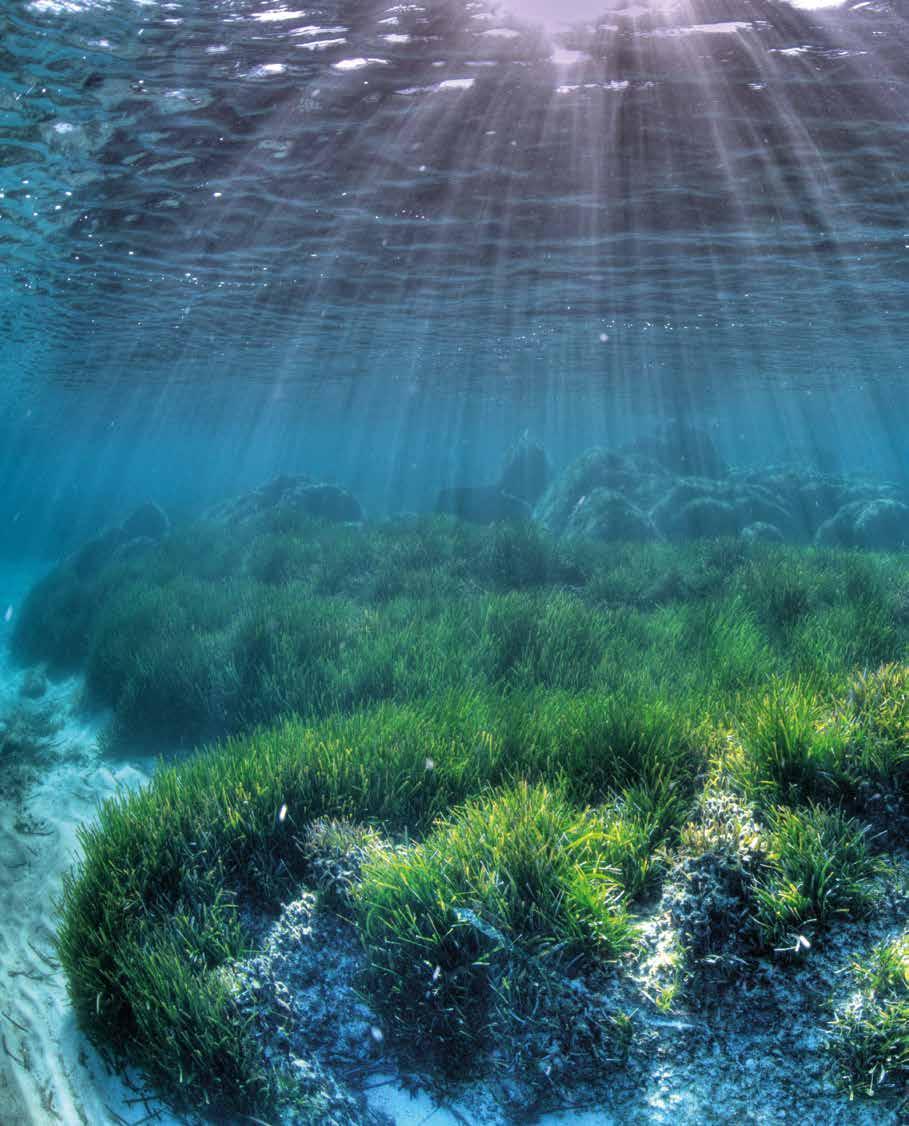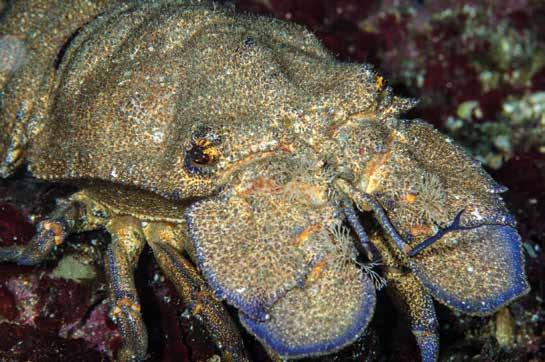
8 minute read
Marine Parks
86 86 marine parks
di Angelo Colombo
Advertisement
Sardegna: il paradiso a nord est
La Sardegna è un luogo noto a molti per il fascino delle sue coste e la qualità delle acque che le bagnano, ma l’isola custodisce una storia millenaria che si esprime con siti archeologici e tradizioni, che ancora oggi sopravvivono tra la gente che la abita

Gli splendidi fondali dell’area a nord est della Sardegna, dove la presenza di grandi praterie di posidonia testimoniano la qualità delle acque
The splendid seabed in Sardinian northest, where the presence of large prairies of Posidonia testifies to the quality of the water
Il mare è la porta di accesso alle innumerevoli risorse di un territorio unico nel suo genere, dove la biodiversità si esprime a livelli straordinari a terra e in mare. Tra le innumerevoli attrazioni per chi soggiorna in Costa Smeralda ci sono anche le escursioni alle aree marine protette, che si estendono verso nord e verso sud partendo da Porto Cervo. La prima è quella del Parco della Maddalena, che dalle isole di Razzoli, S.Maria e Budelli a nord si estende fino all’isola delle Bisce a sud al traverso di Capo Ferro, dunque in prossimità di Porto Cervo, incluse le isole di Soffi, Le Camere e Mortorio. La seconda area marina protetta si trova a sud dell’approdo “principe” della Costa Smeralda: si tratta dell’Area Marina Protetta di Tavolara- Punta Coda Cavallo, che da Capo Ceraso si estende fino a Punta l’Isuledda includendo le isole di Molara, Molarotto, Tavolara, isola Piana, l’Isolotto Rosso e poi le aree di Capo Coda Cavallo, Lu Impostu, la Peschiera di San Teodoro, Porto Taverna. In entrambi i casi si tratta di aree marine ricche di specie animali
e vegetali che le abitano in un contesto ambientale unico nel suo genere e prezioso per chi lo vive in modo stanziale e chi lo visita occasionalmente. L’esigenza di proteggere un ambiente naturale così complesso e caratterizzato da una biodiversità rara e in alcuni casi unica, richiede un’attenzione particolare nelle azioni di tutela operate dai due Enti che ne monitorano lo stato di salute, per questo ci sono zone interdette alla navigazione e soprattutto all’ormeggio, ciò nonostante si tratta di aree visitabili con la propria barca o con un charter: basterà seguire le regole dei due Enti per godere di panorami, acque ricche di vegetazione e fauna, e contribuire al mantenimento del delicato equilibrio ambientale che le caratterizza. Chi ha avuto la possibilità di visitare questi luoghi tende a tornare, a voler ripetere l’esperienza in un ambiente che merita di essere esplorato sotto e sopra la superficie. I numerosi centri diving e noleggio barche di qualsiasi tipo e dimensione, offrono quotidianamente escursioni in luoghi nei quali si riesce a comprendere perché da molti queste coste siano definite il Paradiso. Dalle barche talvolta si ha l’impressione di trovarsi sospesi, con fondali ricchi di flora marina e fauna, che si lasciano apprezzare dai subacquei che solo nell’area del Parco di Tavolara possono contare su 18 punti di immersione. Per quanto riguarda il Parco Nazionale dell’Arcipelago di La Maddalena, questo si estende su una

Sardinia: paradise in the northeast
Undoubtedly, the sea is the gateway to the countless resources
of a unique region, where biodiversity is expressed at extraordinary levels on land and sea. Among the innumerable attractions available, those staying in Costa Smeralda also have access to excursions to protected marine areas, which extend north and south, starting from Porto Cervo. The first one is La Maddalena Park, which from the islands of Razzoli, Santa Maria and Budelli in the north, extends to the island of Bisce to the south, opposite Capo Ferro not far from Porto Cervo, also including the islands of Soffi, Le Camere and Mortorio. The second marine protected area located south of the preeminent port of the Costa Smeralda is the Marine Protected Area of Tavolara – Punta Coda Cavallo, which from Capo Ceraso extends to Punta l’Isuledda including the islands of Molara, Molarotto, Tavolara, Isola Piana, the Isolotto Rosso and then the areas of Capo Coda Cavallo, Lu Impostu, the Peschiera di San Teodoro, Porto Taverna. In both cases, these are marine areas rich in animal and plant species that inhabit them in a unique environmental context, which is precious both for those who live it permanently and those who visit it occasionally. The need to protect a natural environment so complex and characterised by a rare, and in some cases unique, biodiversity requires special attention in the protection initiatives carried out by the two Institutions that monitor its state of health. For this reason, there are places closed to navigation and especially mooring. However, these areas can be visited with an owned or charter boat just following the rules of the two Organisations to enjoy views and waters rich in vegetation and fauna and help maintain the delicate environmental balance that characterises them. The many diving centres and charters of any type and size of boat daily offer excursions to places where you can understand why many define these coasts as Paradise. From the boats, one sometimes has the impression of being suspended above the stunning seabed rich in marine flora and fauna, which is very appreciated by divers who can count on 18 diving points in Tavolara Park’s area only. The National Park of the La Maddalena Archipelago extends over a land area of 5,134 hectares and a sea area of about 13,000 hectares, along 180 km of coastline. and all this is easily and daily accessible from the Costa Smeralda.The Marine Protected Area of Tavolara Punta Coda Cavallo spreads over about 15,000 hectares at sea and 40 km of coasts, the latter characterised by Paleozoic granites that create coves capable of changing colour as the

Immergersi in questi ambienti naturali protetti offre emozioni uniche grazie alla ricchezza dei fondali e ai numerosi incontri con la fauna che li abita. Le coste sono ricche di ridossi naturali e piccole isole con ecosistemi propri e diversificati tra un versante e l’altro
Diving in these protected natural environments offers unique emotions thanks to the seabed richness and the numerous encounters with the fauna that live there. The coasts are rich in natural shelters and small islands, each with its characteristic ecosystem


Incontrare specie animali e vegetali rare e autoctone è una delle possibilità offerte dalle due aree marine protette

Meeting rare native animal and plant species is one of the possibilities offered by the two marine protected areas
superficie terrestre di 5.134 ettari e un’area a mare di circa 13.000 ettari, lungo 180 km di coste. Tutto questo è facilmente e quotidianamente raggiungibile dalla Costa Smeralda, dai tanti approdi che la caratterizzano e che permettono di vivere un’esperienza unica. L’area Marina Protetta di Tavolara Punta Coda Cavallo occupa un’area di circa 15.000 ettari in mare e 40 km di coste caratterizzate dalla presenza di graniti paleozoici che creano cale capaci di cambiare colore al variare della luce e della posizione del sole. Domina l’area la splendida isola di Tavolara, una mole calcarea detta anche isola drago per la sua forma aspra e verticale e poi le isole minori di Molara e Molarotto, Isola Piana e dei Cavalli, queste ultime più arrotondate e granitiche. I fondali sono ricchi di praterie di Posidonia oceanica, varie forme di coralligeno mediterraneo a differenti profondità e scenari subacquei unici. Che si ami immergersi o semplicemente fare snorkeling o anche solo nuotare in superficie, le due aree marine protette sono in grado di offrire al visitatore momenti dove la natura parla di sé e racconta la storia millenaria di un territorio capace di conservarla e condividerla.
light and position of the sun varies. So much Mediterranean scrub where juniper, strawberry tree and phillyrea reach the sea offering images for lasting memories. The beautiful island of Tavolara dominates the area, a limestone mass also called the dragon island for its rough and vertical shape, and then the smaller islands of Molara and Molarotto, Isola Piana and Isola dei Cavalli, which are more rounded and granite. The seabed is rich in Posidonia oceanica prairies, various forms of Mediterranean coral at different depths and unique underwater scenery. The two marine protected areas, although quite close geographically, are two destinations that deserve to be visited and experienced by those who approach the Emerald Coast. Their natural characteristics and the orography of a region capable of changing in a few kilometres make them quite different, although having in common a complex ecosystem unparalleled in the Mediterranean. Spending a day in the beautiful coves of the island of La Maddalena or Caprera towards the north, or Tavolara, Molara and Molarotto towards the south, is an experience destined to remain etched in the minds of those who live it. Whether one loves to dive, snorkel, or just swim on the surface, the two marine protected areas can offer moments where nature speaks of itself, telling the thousand-year-old story of a region capable of preserving and sharing it. Thanks to the many mooring places in the area and numerous charter operators, venturing with one’s own or a charter boat along the coasts of the two marine protected areas is simple and with a guide able to show their beauty in compliance with the rules for environmental protection, the result will be the desire not to go away anymore, to return for sure.











